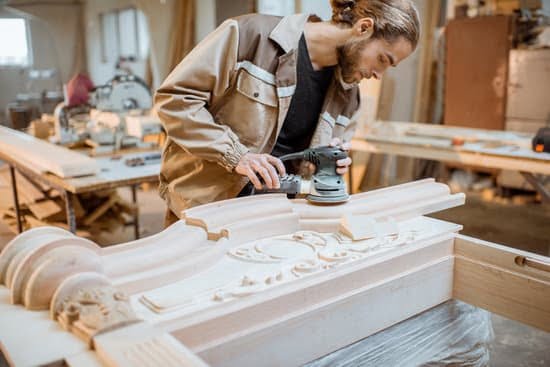When it comes to interior design, custom cabinets and woodworking play a crucial role in creating spaces that are both aesthetically pleasing and functional. Custom cabinets offer the opportunity to tailor storage solutions to specific needs, while woodworking techniques add a touch of artistry and craftsmanship to any room. In this article, we will delve into the world of custom cabinets and woodworking, exploring their significance in transforming ordinary spaces into extraordinary ones.
At its core, custom cabinet making is an art form that allows designers and craftsmen to showcase their creativity and expertise. The beauty of custom cabinets lies in their ability to seamlessly blend style with functionality, elevating any space. Whether it’s a kitchen, bathroom, bedroom, or home office, custom cabinets provide tailored storage solutions that maximize usable space while adding character and charm.
Designing custom cabinets involves understanding the unique needs of the client and incorporating their personal style preferences. From selecting the appropriate wood species to incorporating innovative features and design trends, every aspect requires careful consideration. In this article, we will explore the design process involved in creating custom cabinets, highlighting the importance of craftsmanship and attention to detail.
Furthermore, choosing the right wood for custom cabinets is paramount in achieving both durability and aesthetic appeal. Each wood species has its own unique characteristics such as grain patterns, color variations, and durability levels. We will discuss different wood options available for custom cabinets and provide insights into sustainable choices that are environmentally friendly.
Join us on this journey as we explore the world of custom cabinets and woodworking. From understanding the role of custom cabinets in interior design to showcasing woodworking techniques, finishing touches, application inspirations, financial benefits, and more – discover how these elements can elevate your space into something truly exceptional. Embrace personalized storage solutions with artistic flair by diving into the art of custom cabinets & woodworking.
The Role of Custom Cabinets in Interior Design
Custom cabinets play a crucial role in interior design, transforming ordinary spaces into extraordinary ones. Unlike off-the-shelf options, custom cabinets are tailored to the specific needs and preferences of homeowners, ensuring optimal utilization of space and increased storage capacity. Whether it’s a kitchen, bathroom, living room, or any other room in the house, custom cabinets can make a significant impact on both functionality and aesthetics.
Functionality and Space Optimization
One of the key advantages of custom cabinets is their ability to maximize functionality in any space. Custom cabinets are designed to fit perfectly into the dimensions and layout of a room, utilizing every nook and cranny to its full potential. This means that even in small or oddly-shaped rooms, custom cabinets can be crafted to provide ample storage solutions without compromising on style.
Custom cabinets also allow for creative storage options that address specific needs. For example, pull-out shelves and drawers can be incorporated to ensure easy accessibility to items stored at the back of deep cabinets. Similarly, specialized compartments can be designed for storing appliances or organizing spices in the kitchen.
Aesthetics and Personalization
In addition to enhancing functionality, custom cabinets offer an opportunity for homeowners to express their personal style through unique design elements. Working closely with a skilled cabinet designer or woodworker enables homeowners to have control over every aspect of the cabinet’s appearance – from selecting materials and finishes to deciding on decorative details.
The design possibilities for custom cabinets are vast and varied. From traditional styles with intricate woodwork details to sleek modern designs with clean lines, there is something for every taste. Homeowners can choose from a wide range of colors, finishes, hardware options, and door styles to create cabinets that perfectly complement their overall interior design theme.
Long-Term Investment
Investing in custom cabinets is not only an aesthetic choice but also a wise long-term investment for homeowners. Unlike mass-produced cabinets, custom cabinets are built to last using high-quality materials and expert craftsmanship. This means that they are more durable and resistant to wear and tear.
Custom cabinets also have the potential to increase the resale value of a home. Potential buyers often appreciate the attention to detail and personalized touches that custom cabinets bring to a space. The unique design of custom cabinets can make a lasting impression and set a home apart from others on the market.
Unleashing Creativity
Designing custom cabinets is a truly creative process that allows for the transformation of ordinary spaces into extraordinary ones. At its core, designing custom cabinets involves understanding the unique needs of clients and incorporating their personal style preferences. It requires careful consideration of both form and function to create beautiful and functional storage solutions.
When embarking on the design process, it is crucial to have a clear understanding of the client’s needs and vision for the space. This includes considering factors such as storage requirements, aesthetic preferences, and any specific features or elements they desire. By taking these aspects into account, designers can create cabinets that not only meet practical needs but also reflect the client’s personality and style.
In addition to client input, it’s essential for designers to stay up-to-date on popular design trends in custom cabinetry. This ensures that the end result is not only timeless but also incorporates innovative features that enhance functionality and efficiency. Some current design trends include open shelving, integrated lighting, hidden charging stations, and smart storage solutions.
To further unleash creativity in designing custom cabinets, it’s important to explore different materials, finishes, and hardware options available. Considerations such as wood species, paint colors or stains, and decorative hardware can greatly impact the overall look and feel of the cabinets. Taking risks and trying new combinations can lead to stunning results that truly elevate a space.
Overall, designing custom cabinets allows for a high level of customization that cannot be achieved with mass-produced alternatives. It provides an opportunity to bring individuality to a space while maximizing storage capacity and functionality. By working closely with clients, staying informed on design trends, and experimenting with materials and finishes, designers can create truly exceptional custom cabinets that fulfill both aesthetic desires and practical needs.
| Design Elements | Description |
|---|---|
| Client Needs | The design process begins with understanding the unique needs and vision of the client, including storage requirements and aesthetic preferences. |
| Popular Design Trends | Stay up-to-date on popular design trends in custom cabinetry, such as open shelving and smart storage solutions, to ensure a timeless yet innovative design. |
| Materials, Finishes, and Hardware | Explore different options for materials, finishes, and hardware to unleash creativity and create a unique look for each custom cabinet design. |
Choosing the Right Wood for Custom Cabinets
When it comes to creating custom cabinets, one of the most important decisions is choosing the right wood. The type of wood selected can greatly impact the overall look, durability, and functionality of the cabinets. There are a variety of wood species to choose from, each with its own unique characteristics and qualities. Understanding these options can help ensure that your custom cabinets are not only beautiful but also long-lasting.
One key consideration when selecting wood for custom cabinets is durability. Different wood species have varying levels of hardness and resistance to scratches and dents. For high traffic areas such as kitchens or bathrooms, hardwoods like oak or maple are excellent choices due to their strength and durability. On the other hand, softer woods like pine or cherry may be more suitable for less trafficked areas such as bedrooms or home offices.
Another factor to consider when choosing wood for custom cabinets is grain pattern. The grain pattern refers to the arrangement and appearance of fibers in the wood. This can range from tight and straight grain patterns to more pronounced and irregular patterns. Some homeowners may prefer a consistent and uniform look, while others may appreciate a more rustic or natural appearance with prominent grain patterns.
In addition to durability and grain pattern, color variation is also an important consideration when selecting wood for custom cabinets. Different woods can vary greatly in color, ranging from light blondes to deep reds or dark browns. Some homeowners may prefer a lighter color palette, while others may opt for richer tones to create a warm and inviting atmosphere in their space.
| Considerations | Wood Species |
|---|---|
| Durability | Oak, Maple |
| Grain Pattern | Walnut, Cherry |
| Color Variation | Birch, Mahogany |
When choosing the right wood for custom cabinets, it is also important to consider sustainability and eco-friendliness. As more homeowners prioritize environmental responsibility, there has been an increased demand for responsibly sourced wood options. Hardwoods like oak or maple are generally more sustainable due to their slower growth rates, while certain softwoods such as cedar or pine can be sourced from sustainably managed forests.
Showcasing Craftsmanship
Woodworking is not only an art form but also a craft that requires skillful execution and attention to detail. In the world of custom cabinets, showcasing craftsmanship through various woodworking techniques is essential in creating flawless and durable pieces. This section will delve into the different woodworking techniques used in creating custom cabinets and highlight their impact on cabinet structure and longevity.
Joinery Methods
One of the fundamental aspects of woodworking in custom cabinet making is joinery methods. Joinery refers to how different pieces of wood are connected together to create a solid and long-lasting structure. Two commonly used joinery methods are dovetails and mortise and tenon.
Dovetails are interlocking joints that have been used for centuries due to their strength and durability. These joints consist of wedge-shaped tails on one piece of wood that fit into corresponding sockets on another piece. Dovetail joints not only provide a visually appealing detail but also offer mechanical strength, making them suitable for drawers or boxes.
Mortise and tenon joints involve creating a socket (mortise) in one piece of wood that fits securely with a protrusion (tenon) on another piece. This method creates a strong connection when properly executed, providing stability and longevity to the cabinet’s structure. Mortise and tenon joints are often used in door frames or other weight-bearing areas where extra strength is required.
The Importance of Skilled Craftsmanship
Skilled craftsmanship plays a pivotal role in achieving flawless custom cabinets. It takes years of practice and experience for craftsmen to develop the precision necessary for creating intricate designs with seamless joinery. Attention to detail is crucial as even the smallest flaw can compromise both the aesthetic appeal and structural integrity of a cabinet.
Craftsmen who specialize in custom cabinets possess the knowledge and expertise required to select high-quality materials, understand wood grain patterns, make precise cuts, carefully sand surfaces, and apply finishes flawlessly. They take pride in their work and hold themselves to high standards, ensuring that every piece they create reflects their dedication and expertise.
Attention to Detail
Custom cabinet makers are meticulous when it comes to attention to detail. Every aspect of the cabinet, from the alignment of joints to the flawless execution of decorative elements, is carefully considered and expertly crafted. Intricate detailing such as carved accents or raised panels further enhances the overall beauty and elegance of custom cabinets.
It is this level of craftsmanship and attention to detail that distinguishes custom cabinets from mass-produced alternatives. The value lies not just in the beauty of the finished product but also in its longevity. Custom cabinets designed with precise woodworking techniques by skilled craftsmen have the potential to last for generations, becoming cherished heirlooms within a home.
Finishing Touches
The finishing touches of custom cabinets play a crucial role in enhancing their beauty and overall appearance. The finishing process involves applying different techniques and materials to achieve the desired look and protect the wood. From stains and paints to varnishes and lacquers, there are various options available to create stunning finishes that complement any interior design style.
One important consideration when selecting a finish for custom cabinets is the type of wood being used. Different types of wood react differently to finishes, so it’s essential to choose a finish that enhances the natural beauty of the wood species. For example, a clear or light stain can help bring out the intricate grain patterns of oak or maple, while a darker stain can add depth and richness to cherry or walnut cabinets.
In addition to aesthetics, the choice of finish also affects the durability and maintenance requirements of custom cabinets. A high-quality varnish or lacquer not only adds a protective layer but also makes cabinets easier to clean and maintain over time. These finishes provide resistance against moisture, scratches, and UV rays, ensuring that custom cabinets retain their beauty for many years.
To select the right finish for your custom cabinets, consider factors such as your personal style preferences, the overall color scheme of your space, and the level of durability required for everyday use. It’s also helpful to consult with professionals who specialize in woodworking and cabinet making. They can provide expert advice on suitable finishes based on your specific needs and guide you through the selection process.
By paying attention to the finishing touches of custom cabinets, homeowners can truly elevate their spaces’ aesthetic appeal. The right finish not only enhances the natural beauty of the wood but also protects it from wear and tear, ensuring that these functional pieces remain timeless additions to any interior design scheme.
Custom Cabinets for Every Room
Custom cabinets are a versatile and essential element in every room of the house. From the kitchen to the bedroom, custom cabinets provide tailored storage solutions that enhance the functionality and aesthetics of any space. In this section, we will explore the various applications of custom cabinets and provide design inspiration for different rooms.
- Kitchens: The kitchen is often considered the heart of a home, and custom cabinets play a crucial role in maximizing its efficiency and organization. Custom kitchen cabinets can be designed to fit specific appliances, utensils, and cookware, allowing for seamless workflow and easy access to essentials.
Design options such as pull-out drawers, lazy susans, and built-in spice racks ensure that everything has its place. Additionally, custom cabinets offer endless style possibilities, from sleek modern designs to timeless traditional looks. - Bathrooms: Custom cabinets are essential in bathrooms to optimize storage space and keep toiletries organized. Whether it’s a small powder room or a luxurious master bathroom, custom vanities with built-in storage can create a clutter-free environment while adding elegance to the space.
Floating vanities can also give the illusion of more floor space in smaller bathrooms. Custom medicine cabinets or mirrored cabinets with integrated lighting are popular choices in bathrooms as they combine functionality with style. - Bedrooms: Custom cabinets in bedrooms go beyond traditional wardrobes or closets. They can be designed to make efficient use of space by incorporating features like built-in shoe racks, jewelry organizers, and hidden compartments for valuables. Floor-to-ceiling wardrobes maximize storage capacity while also providing a seamless look in the room. Custom cabinetry can also be used as stylish built-in bookshelves or display cases for showcasing personal treasures.
- Home Offices: A well-organized home office promotes productivity and creativity. Custom cabinetry offers tailored solutions for organizing paperwork, electronics, books, and supplies. Built-in desk spaces with integrated filing systems help keep surfaces clutter-free and ensure a seamless workflow. Custom cabinets can also be designed to conceal printers, shredders, and other office equipment, creating a clean and organized workspace.
- Other Spaces: The possibilities for custom cabinets extend beyond the main living areas. Mudrooms can benefit from custom cabinets with built-in benches and storage compartments for shoes, backpacks, and outdoor gear. Laundry rooms can have custom cabinetry that includes hampers, folding stations, and concealed ironing boards. Custom cabinets in entertainment rooms can house audio-visual equipment and provide storage for media collections.
The Value of Custom Cabinets
Investing in custom cabinets is not only a wise decision but also a smart investment for homeowners. Custom cabinets offer numerous benefits and add significant value to a home, both in terms of aesthetics and functionality. Unlike mass-produced alternatives, custom cabinets are tailored to fit the specific needs and preferences of the homeowner. They not only enhance the overall look of a space but also provide long-lasting durability that can withstand daily wear and tear.
One of the key advantages of custom cabinets is their ability to increase home resale value. Potential buyers are often drawn to homes that have unique and customized features, such as custom cabinetry.
These cabinets elevate the appeal of a space, making it more attractive to buyers who are willing to pay a premium price for a well-crafted and personalized living environment. In fact, studies have shown that investing in custom cabinets can yield an impressive return on investment when it comes time to sell a home.
Another reason why custom cabinets are considered a wise investment is their longevity compared to mass-produced alternatives. Custom cabinets are built with superior craftsmanship and attention to detail, ensuring that they will stand the test of time.
The use of high-quality materials and precise woodworking techniques results in sturdy cabinets that can handle heavy items without warping or breaking. This durability not only saves homeowners from having to replace their cabinets frequently but also contributes to their long-term financial savings.
To further emphasize the value of custom cabinets as a wise investment, it is beneficial to provide real-life examples and testimonials from satisfied homeowners who have experienced firsthand the positive impact these cabinets have had on their homes. Whether it’s increased functionality, improved organization, or enhanced beauty, these testimonials help showcase the tangible benefits that come with investing in custom cabinetry.
Conclusion
In conclusion, custom cabinets and woodworking play a crucial role in elevating living spaces. By incorporating custom cabinets into interior design, ordinary spaces can be transformed into extraordinary ones. The ability to optimize space utilization and increase storage capacity is a major benefit of custom cabinets. Designing these cabinets involves a creative process that requires understanding client needs and preferences, as well as staying up-to-date with popular design trends and innovative features.
Selecting the right wood for custom cabinets is essential in achieving the desired aesthetic and durability. Different wood species offer unique characteristics such as grain patterns, color variations, and durability levels. It is important to consider sustainable and eco-friendly wood choices as well.
The value of skilled craftsmanship and attention to detail cannot be overstated when it comes to woodworking techniques for creating flawless custom cabinets. Joinery methods such as dovetails and mortise and tenon are key in ensuring cabinet structure and longevity.
The finishing process further enhances the beauty of custom cabinets. Selecting the appropriate finish, whether it be stains, paints, or varnishes, greatly impacts the appearance and durability of the cabinets.
Custom cabinets have applications in every room of the house, offering tailored storage solutions specific to each room’s requirements. From kitchens to bathrooms, bedrooms to home offices, there is endless inspiration for incorporating custom cabinets into any living space.
Investing in custom cabinets is a wise decision that adds long-term value to a home. Not only do they increase resale value compared to mass-produced alternatives but they also stand the test of time.
Frequently Asked Questions
Is it cheaper to build cabinets or buy them?
The cost of building cabinets versus buying them can vary depending on several factors. In general, building cabinets yourself can be a more cost-effective option, especially if you already possess the necessary skills and tools. By purchasing the materials directly and eliminating labor costs, you may be able to save money.
However, it’s important to consider that building cabinets requires time and effort, as well as expertise in woodworking or cabinetry. If you lack these skills or prefer a quicker solution, buying pre-made cabinets from a store or hiring a professional might be more suitable.
Are custom cabinets worth the money?
Custom cabinets can indeed be worth the money for many individuals, depending on their specific needs and preferences. One significant advantage of custom cabinets is the ability to tailor them precisely to your space requirements and desired style.
They offer a greater degree of flexibility when it comes to design options, allowing you to choose materials, finishes, hardware, and layout according to your personal taste. Additionally, custom cabinets are typically crafted with higher quality materials and superior craftsmanship compared to mass-produced options, resulting in durability and longevity.
What are the disadvantages of custom cabinets?
While there are numerous advantages to custom cabinets, it’s essential to acknowledge some potential disadvantages as well. The primary disadvantage is usually the higher cost associated with customization. Custom cabinets often come at a premium price due to the personalized nature of the product and the additional time needed for design work and production.
This higher cost may not fit within everyone’s budgetary constraints. Moreover, since custom cabinetry involves working with an individual designer or cabinet maker, there can be longer lead times for completion compared to off-the-shelf options available immediately in stores. It’s crucial to weigh these drawbacks against the benefits before making a decision about whether or not custom cabinets are right for you.

Hi everyone! I’m a woodworker and blogger, and this is my woodworking blog. In my blog, I share tips and tricks for woodworkers of all skill levels, as well as project ideas that you can try yourself.





